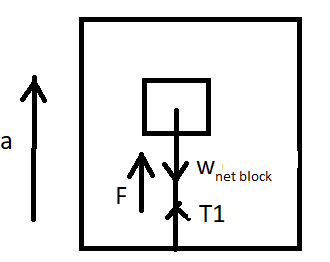Question
Question: The tension in a string holding a solid block below the surface of a liquid (where \({\rho _{liquid}...
The tension in a string holding a solid block below the surface of a liquid (where ρliquid>ρblock) as shown in the figure is Twhen the system is at rest. Then what will be the tension in the string if the system has upward acceleration a?

(A) T(1−ga)
(B) T(1+ga)
(C) T(ga−1)
(D) gaT
Solution
Firstly we have to draw a free body diagram showing all the forces in the system in both cases. First, when the system is at rest. Second when the system is moving with acceleration a. The forces that are involved in both the cases are the tension force in the string acting upwards, the weight of the block acting downwards and the buoyant force exerted by the liquid. The magnitude of the buoyant force can be calculated by finding the weight of the liquid displaced when the block is put in the liquid. After finding the equations for the sum of all the forces in both the cases we rearrange the second equation in a manner that we can express it in terms of equation one. This will give us the relation between tensions in both cases.
Formula used:
Buoyant force, Fbuoyant=mlg=vρlg, where ml,v,g,ρl are the mass of liquid, the volume displaced, gravity, the density of liquid respectively.
Complete step by step solution: From the question we know that the block is below the surface of the water and assuming the volume of the block as v then the volume of water displaced will be v.
From the formula of buoyant force, Fbuoyant=mlg=vρlg(because Mass = Volume \times Density)Theequationforthefirstcasewherethereisnoaccelerationwhenthesystemisatrest.Freebodydiagramofthefirstcase,Whenitisatrestitmeanstheblockisatequilibriumwithrespecttothebeaker.Thistellsusthatthenetforceiszeroontheblock.{w_b}, T,{\rho s}aretheweightoftheblock,thetensioninthestringatrest,thedensityoftheblock(solid). {w_b} + T = {F{buoyant}} v{\rho _S}g + T = v{\rho _L}g \dfrac{T}{g} = v{\rho _l} - v{\rho _s} $
The equation for the second case when the system is moving with acceleration upwards, this causes an increase in buoyant force due to increased displacement of liquid.
Free body diagram in the second case,

Fbuoyant=vρl(g+a)
wblock=mb(g+a)−mbg
mba=vρsa
By balancing the forces we get, T1 is the tension in the string when the system is being accelerated. wnetblockis the weight of the block while the system is being accelerated.
wnetblock=Fbuoyant−wb−T1
vρsa=vρl(g+a)−vρsg−T1
0=(Vρlg−vρsg)+(vρl−vρs)a−T1
Substituting the first equation, vρlg−vρsg=T in second, We get,
T+(gT)a=T1
T1=T(1+ga)
Hence, the correct option is (B), T(1+ga).
Note: Always remember that the buoyant force can be derived from the weight of the liquid displaced, which is why the density of the liquid is directly proportional to the buoyant force. Because the system is being accelerated upwards the buoyant force increases, on the other hand, if the system is being accelerated downwards then the buoyant force decreases.
